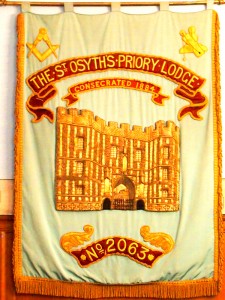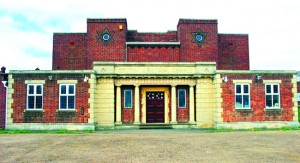ABBEY OR PRIORY OF ST. OSYTH.
 Back in the 7th Century we first find records of this place as part of the possessions of Sigherc, King of Essex ; it is called in the records Clce, Chich, Clca, Cicce, Clta, Clhc, Ciz, and later St. Osith. Wynkyn de Worde printed in 1516 the 14 Nova Legcnda Angliae ; ” in this work Capgravc gave the life of St. Osyth of which the following is a precis.
Back in the 7th Century we first find records of this place as part of the possessions of Sigherc, King of Essex ; it is called in the records Clce, Chich, Clca, Cicce, Clta, Clhc, Ciz, and later St. Osith. Wynkyn de Worde printed in 1516 the 14 Nova Legcnda Angliae ; ” in this work Capgravc gave the life of St. Osyth of which the following is a precis.
St. Osyth, or Osgith, was the daughter of Frithuwald, King of Surrey as tributary of the King of the Mercians ; that he was a Christian is proved by his part in founding and endowing Chertsey Abbey (A.D. 666) and Wllburga, daughter of Penda, King of Mcrcia, she was born at Quarendon in Aylesbury, and brought up by her aunt at Elesborough, 3 miles from Aylesbury. She made a vow of virginity and many miraculous events are recorded of her life here but her father compelled her to marry Sighere ; however, the marriage was never consummated as immediately after the wedding the King was enticed forth to the chase by the appearance of a splendid white Stag before the doors of the palace. She fled with her maids and took the veil ; he at last forgave her and gave her his village of Chich, where she founded a Church to the honour of St. Peter and St. Paul and instituted a nunnery of the order of the Holy Trinity. In or about the year 665 a party of Danish Pirates under Inguar and Hubha sailed up the Colne, spoiled the village and monastery of St. Osyth. After trying their utmost to make her worship their idols and after persistent refusals, they struck off her head. Under angelic guidance, she walked with her head in her hands to the Church built near the Nunnery, knocked at the door with her blood stained hands, and then fell dead, and according to the legend, a fountain of clear water gushed forth from where she fell. The reputed site of the Nunnery is in the ‘Nun’s Wood’ in the N.W. corner of the Priory Park. The traditional spring is still running and near it are the ruins of a little early 14th Century building which was probably the conduit house connected with supplying water to the Monastery. Her body was removed to Aylesbury for 46 years for fear of the Danes, and was then brought back in consequence of a vision by a tradesman of that town. (Recorded in Leland’s Itinerary Vol. VIII.). Many miraculous cures are recorded of pilgrims to her tomb and also of punishments to various people who disbelieved or who had desecrated the Church or the Abbey. Her festival was on the 7th of October
THE HISTORY OF THE PRIORY.
 After the destruction of the Nunnery by the Danes, the parish reverted to the Crown. King Canute granted It to Godwin, Earl of Kent; he gave it to Christ’s Church in Canterbury by licence of Edward the Confessor. It was taken from this Church at the Conquest and at the time of the Survey belonged to the Bishops of London. The rest of the lands which before the Conquest belonged to one Edward and to Siwcard were held at the Survey by Eustace, Earl of Boulogne, Ralph Pcverell and his under tenant, Turold ; these lands and the Bishop’s afterwards formed a large part of the Endowment of the Priory.
After the destruction of the Nunnery by the Danes, the parish reverted to the Crown. King Canute granted It to Godwin, Earl of Kent; he gave it to Christ’s Church in Canterbury by licence of Edward the Confessor. It was taken from this Church at the Conquest and at the time of the Survey belonged to the Bishops of London. The rest of the lands which before the Conquest belonged to one Edward and to Siwcard were held at the Survey by Eustace, Earl of Boulogne, Ralph Pcverell and his under tenant, Turold ; these lands and the Bishop’s afterwards formed a large part of the Endowment of the Priory.
In the reign of Henry I, Richard de Bclmeis (de Beaumels or Beauvays), Bishop of London, who was consecrated 1108, obtained it from the Church of St. Paul, London, giving in exchange lands in Sussex and Southminster, and built a religious house of regular Canons of St. Augustine in honour of the two apostles, St. Peter and St. Paul, and also of St. Osyth. Thus the Priory was founded. The original endowment was speedily increased by various grants and before the end of the 12th Century, the Priory was one of the wealthiest religious houses in the Kingdom. Under their charters the Canons of St. Osyth were empowered to apprehend, try, and punish thieves and other malefactors in their domains ; they held a market of their own for some centuries as is shown in 1317 by the Presentments at Colchester Edward II. (10), also the privilege of hunting in their woods without molestation of King’s foresters, and were free of almost all suits, services and Taxes ; so that before the dissolution the neighbourhood for miles round was dominated by the Priory of St. Osyth.
On the 9th July, 1534, John Colchester or Withcrick, with the Prior, and 17 Canons subscribed to the King’s supremacy. For this submission they were all rewarded with pensions for life. Abbott Colchester £100 and the rest smaller sums.
The King’s Commissioners for receiving possession of the Priory and its goods were Sir John St. Clair of St. Clair Hall, St. Osyth, Sir William Purton, John Peteynes (Clerk), Thos. Mildmay, and Francis Jobson. Sir Thomas Audley, then Lord Chancellor, endeavoured to obtain possession of the Abbey and its lands but Thos. Cromwell obtained it for himself; after his execution it reverted to the Crown. Henry VIII appointed Sir Thos. Darcy keeper of the Priory, etc., during his lifetime. Edward VI settled it on Princess Mary, afterwards Queen Mary. Sir Thos. Darcy who had been created Baron Darcy of Chich desired it, and on 1st June, 1553, the King granted the Princess other estates and sold it to him for £3,974 9s. 4d. The 3rd Lord Darcy was made Viscount Colchester by James I, and Earl Rivers by Charles I. His son died in 1613 without heir, but the Estates were allowed to pass to the Savages of Rocksavagc in the County of Chester through the marriage of Elizabeth, his eldest daughter to Sir Thos. Savage. In 1639 this said daughter came into possession of the Priory; in 1641 the King created her Countess Rivers. In 1642 during the Commonwealth, she being a Royalist, the mob sacked the Priory.
At the Installation meeting held on Friday, October 18th, 1918, an interesting link was formed again with St. Osyth’s Priory when W. Bro. A. E. Cowley, M.A.. D.Litt., P.G.D., the then owner of St. Osyth’s Priory was unanimously elected an honorary member of the Lodge.
Sir John H. Johnson purchased it from Mr W. F. Nassau in 1857, and sold it in 1920 to Bri. Gen. Kincaid-Smith
See Past Master



